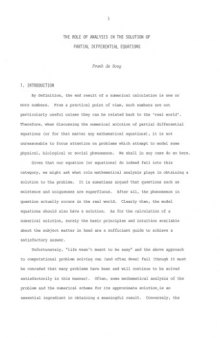 جزییات کتاب
جزییات کتاب
In early February 1984 the Centre for Mathematical Analysis at the Australian National University sponsored a seminar on the contribution of mathematical analysis to the numerical solution of partial differential equations. The seminar was held at Merimbula, N.S.W. in conjunction with the Australian Mathematical Society's 1984 Applied Mathematics Conference. The aim of the seminar was to illustrate some of the ways in which mathematical analysis can provide insights into numerical methods for the solution of partial differential equations, insights that may not always be apparent from purely physical or traditional engineering points of view.This volume contains the complete proceedings of the seminar. The papers have been grouped as indicated in the contents. This arrangement has been something of a compromise, with a number of papers properly belonging under more than one heading.In his introductory paper F. de Hoog starts by illustrating how the simplifications inherent in any mathematical model may often lead (unexpectedly) to solutions which possess quite unrealistic features. However such solutions may still convey meaningful qualitative and quantitative information. Turing to numerical methods for solving the mathematical model, he points out by example, that although some discretizations may seem physically reasonable at first sight, they may nonetheless have serious mathematical problems.R. Anderssen considers some of the issues which arise in choosing the basis functions for spectral (global basis function) methods. In his aper F. Stenger discusses some of the properties of the so called sinc functions with reference to their use as basis functions for spectral methods.C. Fletcher describes the Dorodnitsyn formulation of the turbulent boundary layer equations and considers associated spectral and finite element discretizations.I. Babuška and V. Majer consider a class of factorization methods which convert a two point boundary value problem to an initial value problem. Various finite difference schemes for the boundary value problem and discrete methods for the initial value problem can then be seen as equivalent. The paper by H.O. Kreiss illustrates one way of handling initial value problems with multiple time scales in cases where the interest is only in the slowly varying solution. J. Noye decribes some of the refinements necessary in explicit finite difference schemes so that they can reasonably handle wave propogation phenomena.In his paper N. Barton reviews some of his experience with software packages for method of lines solutions of time dependent problems.Turning to finite element methods, G. Carey surveys some of the problems which can arise in using nonconforming finite elements. He then discusses the source of some of these difficulties and some ways they may be overcome. A. Miller presents a non-standard technique for extracting approximations for certain functionals from finite element solutions of problems in linear elasticity etc.In his paper G. Chandler reviews the boundary integral formulation of elastostatic and related problems, and then discusses some of the computational problems that may arise from the singular nature of the solution at critical boundary points (e.g. reentrant corners). In the final paper W. McLean addresses this latter point in more detail for the particular case of a double layer potential formulation of the Dirichlet problem for Laplace's equation on a polygon.



 دانلود کتاب
دانلود کتاب

 جزییات کتاب
جزییات کتاب





 این کتاب رو مطالعه کردید؟ نظر شما چیست؟
این کتاب رو مطالعه کردید؟ نظر شما چیست؟
